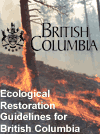 |
|

Developing
Prescriptions
Final restoration objectives can now be set,
based on the site survey and maps. Your prescriptions should take
the form of maps showing the treatment locations, accompanied by the
rationale for treatment, descriptions of treatments, and treatment
schedules and costs (see Restoration Plan example, Appendix
1). Restoration prescriptions will also include future maintenance
and monitoring requirements, and will take into account safety and
other logistical concerns.
Some considerations common to many projects are listed below.
In a world of limited funding, it is important to prioritize treatments;
for example, present each site or prescription type in terms of high,
medium, and low priority. At the stage of prescription development,
it is also wise to involve key players (see below).
It's important to note that prescribing no treatment is often a valid
option - either because the ecosystem is healing itself satisfactorily,
or because the problem is too difficult or expensive to fix.
| Checklist for Prescription
Development |
| |
Good Restoration Prescriptions Are:
- Cost effective
- Likely to succeed
- High priority
- Reasonable in maintenance requirements
- Approved by key players
|
Involving Key Players in Prescription
Development
Using Experts
Most restoration projects require professional
advice in the planning and prescription development stages. An appropriate
specialist can usually be found by asking key
players, or by making inquiries to the BC
Chapter of The Society for Ecological Restoration.
Involving Stakeholders
Government, First Nations, commercial interests,
or other key players will
often have some say in what happens, and for prescription development
you will need their buy-in. The best way to solicit input is to
have these parties visit the site before the plans are finalized.
It is at this stage that you can get technical input and future
commitments to your plans, often for free.
The local community may also need to play a role or be educated
about the restoration project. An example of the need to involve
the community is where community viewscapes or recreation opportunities
will be affected, or where there is a perception of risk to private
property. The importance of community buy-in cannot be overemphasized
on these types of sites, as an uninformed and unhappy public can
successfully oppose your restoration plans. Another important reason
for community education is to create potential volunteers that may
lend a hand to your efforts, and assist in stewardship and monitoring
in years to come.
Common Restoration Considerations
Some special considerations must be taken into account, depending
on your site and project. Table 5 lists some common considerations,
which are also explained individually below.
Planting Prescriptions
Planting trees, shrubs, or grasses is part of many restoration projects.
It is important to consider the timing of planting, type of planting
stock, and hazards to the planted stock, such as drought or disturbance
by animals. The specific timing of planting will depend on your
region, but it is generally in spring or fall, when there is enough
moisture to allow the plants to establish. In particularly vulnerable
areas, irrigation, though expensive, may be the only way of ensuring
survival through the summer months.
Choosing the right type and size of plant stock is important to
help ensure the plant's survival. Local plant stock should be used
whenever possible, because it may have attributes that will help
it survive better. Using local stock is easiest when the project
involves using deciduous cuttings or "whips" (e.g., dogwood,
willow, or cottonwood) that can be collected from nearby sites,
as long as care is taken not to overharvest the source populations.
Local native vegetation is rarely available in quantity from nurseries
without special ordering, thus it may take advance planning to collect
and grow local trees, shrubs and herbs, something your local nursery
can do if given enough notice. Generally, a lead time of two or
three years will be required to collect seed and grow the plants
to sufficient size. If you are time-limited and wish to purchase
standard trees from a nursery, you will usually obtain different
stock than would exist in your area, though controls exist in BC
to ensure that tree seedlings are ecologically appropriate for the
general region. In general, the largest possible tree stock should
be used, in order to maximize survival and minimize maintenance.
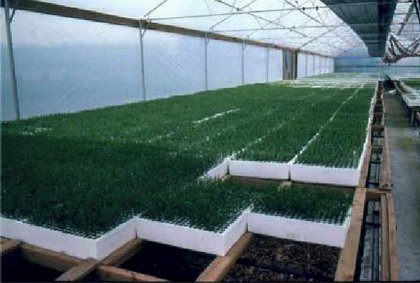
Dave Polster
Contracting with a nursery to grow the
plants you need is an effective way of ensuring the right materials
are available.
On barren, disturbed sites
where erosion control is the objective, you may decide to seed grasses
and legumes for quick ground cover. However, native grass seed mixes
are not commercially available at present, though several projects
are underway to improve this situation. Restorationists should be
on the lookout for native seed options as they develop. Another
consideration for grass seeding is the avoidance of dense, sod-forming
species in the wetter zones of the province. Dense grass sod can
out-compete planted trees, exclude later seral species from establishing,
and harbour rodent populations that will girdle trees. Your seed
supplier will be able to exclude or balance the sod-forming species
in your seed mix, upon request.
Once the trees or shrubs are planted, you often need to protect
them from animals. You'll need to make inquiries about the risk
of animal damage in your area, and monitor your planted stock closely
to make sure you are not simply providing animal food. Deer browsing
is a big problem in most areas, and protective tree covers are commercially
available to allow trees to attain heights where deer are less interested
in browsing. Trees planted in grassy areas are prone to girdling
from rodents, and rabbits will also girdle trees. If you are planting
cuttings near a beaver dam you can expect the beaver to take some,
and should think about a fence to exclude the beaver.
Trees and shrubs should be planted at densities higher than the
final target, to account for mortality due to animals, disease,
and drought. Once trees are well-established, thinning may be necessary
in order to establish a tree density appropriate for the site.
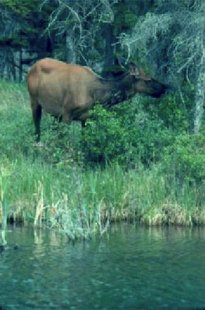
Dave Polster |
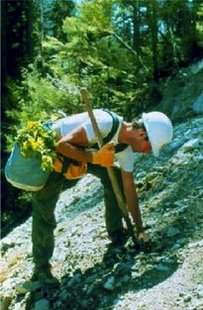
Dave Polster |
| Grazing animals can severely damage
planted stock. |
Planting programs must be conducted
when the conditions are optimum for plant growth. Avoid times
when the newly planted materials will be stressed due to lack
of moisture. |
Invasive Species
There are many invasive non-native species,
both plant and animal, that are a major restoration concern in British
Columbia. Many restoration projects simply attempt to control the
invasive species to allow native ecosystems to re-establish. For
example, much effort goes into Scotch broom eradication on eastern
Vancouver Island, and knapweed control in the dry interior. Restoration
efforts may also open up an area to problem invasive plants by disturbing
soil or increasing light availability. Restorationists must take
care to not make the problem worse.
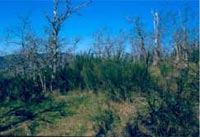
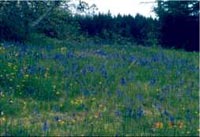
Dave Polster
The effects of Scotch broom removal on Garry
oak communities can be dramatic, as seen in these before (left)
and after (right) photos taken 5 years apart in the same general
area.
Invasive exotic species are
highly competitive and are difficult to eradicate, as they lack
the predator, competitor and disease controls from their native
environments. Many weedy plant species produce large numbers of
seeds that can persist in the soil for decades. The long-term presence
of these invasive weeds and animals degrades ecosystems through
competition, exclusion, and predation on native plants and animals.
While eradication of all but the most recent arrivals isn't likely,
with vigilance and effort their numbers can be controlled.
In previously forested environments, establishing fast-growing native
trees and shrubs will usually shade out the light-requiring exotics.
For example, red alder, willow, dogwood, and cottonwood can be used
on the coast to shade out problem species like reed canarygrass
and blackberry, and re-establishing Douglas-fir forests will eliminate
Scotch broom.
In many places in the dry interior the weed problem is severe. Biological
controls are used for some of these species, and should form part
of a restoration program in areas where they can be applied. Other
methods of control are hand-pulling, mowing, or in special cases,
using herbicides.
| Herbicides |
| Herbicides are used to control unwanted vegetation, like
exotic weeds. However, in ecological restoration projects they
are not usually the method of choice, as they may kill native
species or lead to other problems in the ecosystem. The ability
of herbicides to be selective is related to a higher tolerance
of the poison by some species compared to others. Some authors
believe that using herbicides creates a disturbance into which
weeds invade, thereby worsening the problem (Polster and Landry
1993). Where herbicides are chosen to control problem weeds,
follow-up monitoring will be necessary to discern whether they
are having their intended effect. |
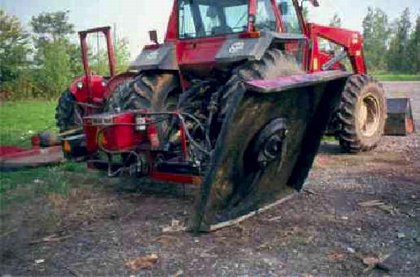
Dave Polster
Mowing can be an effective strategy for control
of some unwanted invasive plants as it can remove the seed portion
of the plant, impeding the plant's ability to propagate.
Information on managing invasive plant species
may be obtained from a variety of resource agencies as well as private
groups such as the Cattleman's Association. Information on control
of some specific invasive species can be obtained from researchers
at universities as well as Ministry of Forests research stations
throughout the province. However, as much information as there is
on the control of weeds, there is relatively little information
on the management of invasive species in the context of ecosystem
restoration. Adopting treatment methods that are used in agriculture
or forestry may be inappropriate within the context of ecological
restoration. Developing a strategy for environmentally sensitive
management of invasive species requires careful consideration of
the ecological consequences of the various potential management
techniques.
Species At Risk/
Species Needing Special Management
Even when your restoration project is addressing ecosystem or habitat-related
restoration needs, single species are usually a consideration. You
should have identified any species of concern early in your information-gathering
phase (see 'Gathering Information
and Data'). At the very least, your plans should ensure that
you will not harm species at risk, and ideally your restoration
program should attempt to restore both the species and its native
ecosystem.
Working with rare and endangered 'species at risk' will require
agency buy-in. If your plans include restoration of rare plants,
the Native Plant Society of BC can also provide advice on your strategy,
and guidelines to avoid damaging limited populations through collection
of seeds or plant parts. (Contact information for the Society can
be found at: http://www.vcn.bc.ca/npsbc/).
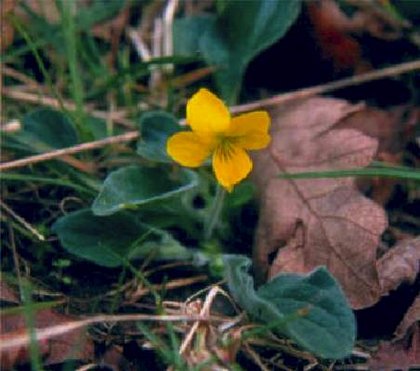
Dave Polster
The yellow montane violet (Viola praemorsa)
is a species at risk in the Garry oak ecosystems of SE Vancouver
Island. Restoration efforts in these ecosystems must ensure that
these important ecosystem elements are not lost.
Many species that are not
officially 'at risk' may also require special consideration
in your plans,
due to specific habitat needs that wouldn't otherwise be met, possible
impacts to their habitat caused by your restoration project,
or
because of their importance to the ecosystem. For example, certain
species use tree cavities to nest, roost, and feed, and populations
of these species are generally depressed or absent due to a lack
of adequate habitat. Second growth forests, even when thinned
in
order to develop old-growth characteristics, will lack these cavity
features for decades. Techniques are under development to create
cavities and rot in trees, and using these techniques is an example
of the fine-filter approach
to restoration, within the context of stand-level (coarse-filter)
treatments like thinning and fire. If you require information about
individual species in your ecosystem, your regional office of the
Ministry of Environment may be able to help.
Values at Risk
Restoration work may involve risk to ecological values or species
at your site, as well creating risk to property values. As part
of your planning process you should ensure that any risk is warranted
and mitigated. Getting the proper permits, making detailed plans,
and consulting with the community will lower your liability and
your risk.
An obvious example of managing risk is with fire-supported restoration.
If you plan to do a prescribed burn, you will need to manage risk
to organisms and habitat features on the site, as well as ensure
that your fire doesn't escape and damage property. Other options
besides fire will need to be explored when the risk or consequence
of failure is too high.
Soil Rehabilitation
If you have reason to believe the soils on your site have been altered
and will not support your desired vegetation, you may have to address
soil compaction or lack of nutrients and organic materials as one
of your first restoration activities. Without the proper soil conditions,
your desired plant community may not become established.
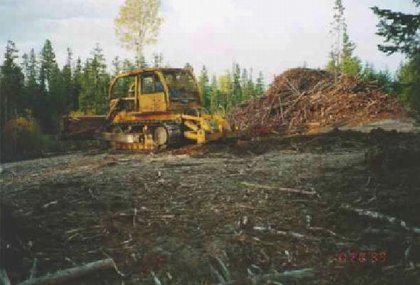
Chuck Bulmer
Soil ripping is an important part of soil rehabilitation
where soil compaction is a problem, such as on roads and landings
where heavy equipment has operated.
If your site was used for industrial
or urban activities, soil compaction caused by heavy machinery may
inhibit plant growth. "Ripping" old roads and landing
sites might be required to loosen up the ground for growing plants.
Industrial areas also tend to suffer from the removal of topsoil.
Chemical fertilizers or organic mulch can be used, and sometimes,
the planting of nitrogen fixing plant species such as legumes and
alder is useful. Adding old logs and stumps (coarse
woody debris) to the soil surface will help the area
recover moist microsites and organic material, and may speed up
recovery of the ecosystem. These activities might be enough to start
the process of succession. Comparison with a reference ecosystem
will help illustrate the appropriate chemical and physical goals
for your degraded soils.
Methods used to reclaim mine sites must be used with caution in
ecological restoration. Soil amendments like manure and biosolids
can alter natural soils and may introduce foreign materials to your
site.
The Forest
Practices Code Soil Rehabilitation Guidebook (Province of BC
1997) provides a good discussion of all types of soil rehabilitation
in BC. This and other guidebooks are available for purchase through
the Crown Publications Index: www.publications.gov.bc.ca.
Slope Instability/
Bioengineering
Unstable areas can remain unvegetated for years. When the source
of the instability is below the surface, devastating landslides
can result. Most slope instability is caused by forestry or mining
access roads, where older techniques of road building have created
unstable 'fill' slopes, steep 'cut' slopes, and harmful drainage
pathways. It is important to consult an experienced geoscientist
in cases of slope instability. In addition, when addressing instability
as part of an ecological restoration project, you will need to give
special consideration to the types of plant material used to revegetate
the area.
Road and hillslope related rehabilitation is discussed in detail
in the publication "Best Management Practices Handbook: Hillslope
Restoration in British Columbia. Watershed Restoration Technical
Circular No. 3 (revised), (Atkins et al. 2000). This publication
is available from the Ministry of Forests: http://www.for.gov.bc.ca/RTE/engineering/wrp-pub.htm.
Surface instability can be treated very effectively with soil bioengineering
techniques, where live materials are used to create physical stability.
Growth of these materials allows the process of succession to begin.
See Polster (2001) for more information on using bioengineering
techniques in restoration. Bioengineering courses are offered through
the Forestry Continuing Studies Network (see Resources section.)
| Common Bioengineering
Techniques |
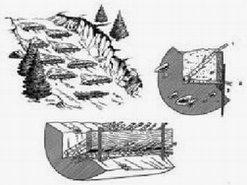
Dave Polster |
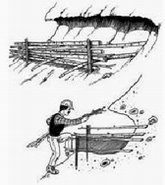
Dave Polster |
| Modified brush layers are used on steep
ravelling slopes to stop the rolling stones and allow vegetation
to establish. The cuttings are placed above the board on moderate
sites (1), on dry sites they are placed below the board (2),
while on wet sites a small wattle fence is built below the board
(3). |
Live reinforced earth walls are used
where slumping has resulted in a cavity in the slope. Backfill
comes from shaving the slope above the cavity. |
Cost Effectiveness
Restoration dollars are always at a premium.
Hence, cost-effectiveness should always be explored, and treatments
must be prioritized based on need and on the benefit relative to
the cost. Often, operational trials can be done to explore whether
cheaper methods yield acceptable results. More expensive techniques
don't necessarily translate into improved performance. An example
is establishing trees like red alder: nursery-grown trees are expensive
to buy and plant, and direct seeding may provide a reasonable alternative
at a fraction of the cost (Warttig and Wise 1999). Restoration techniques
that work with natural processes like succession will be the most
cost effective, and the most likely to succeed.
Including Maintenance in your Restoration
Prescriptions
Maintenance is so important to restoration that a section is devoted
to it later in these guidelines (see 'Maintenance').
However, mention is also warranted here. Maintenance needs will
determine the cost effectiveness and feasibility of a prescription,
and these needs must be considered when choosing the appropriate
prescriptions to implement. Good restoration prescriptions will
include maintenance in the budget and schedule of activities.
|






